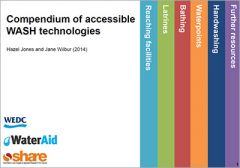Compendium of accessible WASH technologies

Addressed mainly to staff directly working with low-income communities, such as health workers and community volunteers, this guide compiles examples of low-cost technologies to improve accessibility to water and sanitation in Sub-Saharan Africa. It says that it is for rural areas but many of the examples are valuable for illustrating improvements that may be relevant in urban contexts too.
Although designed to improve access to water, sanitation and hygiene (WASH) facilities for (physically and visually) disabled users and older people, the guide notes that improvements might also benefit other vulnerable groups such as children, pregnant women, overweight people, and people with limited strength who have difficulties in carrying heavy loads – e.g. buckets or jerry cans for transporting water. Furthermore, improvements can make access easier, or facilities more comfortable, for everyone living in the same household or community. The guide emphasizes that the technologies need to be adapted to suit the needs of each user and the resources of each household. Users might have different types of disability, employ diverse mobility devices, or require specific adjustments according to their height and weight. Similarly, each household has its own budget, has access to specific local materials, and lives in a particular terrain.
The compendium is organized into five different sections, namely: Reaching Facilities, Latrines, Bathing, Waterpoints and Handwashing. Images and sketches show the innovation and tables compare alternatives in terms of mode of construction, advantages, disadvantages, potential improvements/variations, and relative costs. Special consideration is given to for whom and for which terrain each technology is suitable. Readers can easily explore a range of options for improvements to increase access to water and sanitation facilities.
Accessibility is not simply understood as “as much independent access as possible”; hygiene, privacy and safety are also highlighted as important elements to consider when deciding on the type of technology to implement. For example, certain materials are easier to clean, wash or wipe than others; adding a bolt or hook to the door of a latrine can provide greater privacy, especially for girls and women; and adding cross-hatching on concrete ramps can reduce the risk of slipping when the surface is wet. A list of suggested further resources complements this guide.
The guide can be downloaded from: http://www.wateraid.org/what-we-do/our-approach/research-and-publications/view-publication?id=aff6d098-00f2-42e5-b9a0-22ec2b264a5e
Book note prepared by María Evangelina Filippi
Search the Book notes database
Our Book notes database contains details and summaries of all the publications included in Book notes since 1993 - with details on how to obtain/download.
Use the search form above, or visit the Book notes landing page for more options and latest content.
For a searchable database for papers in Environment and Urbanization, go to http://eau.sagepub.com/

